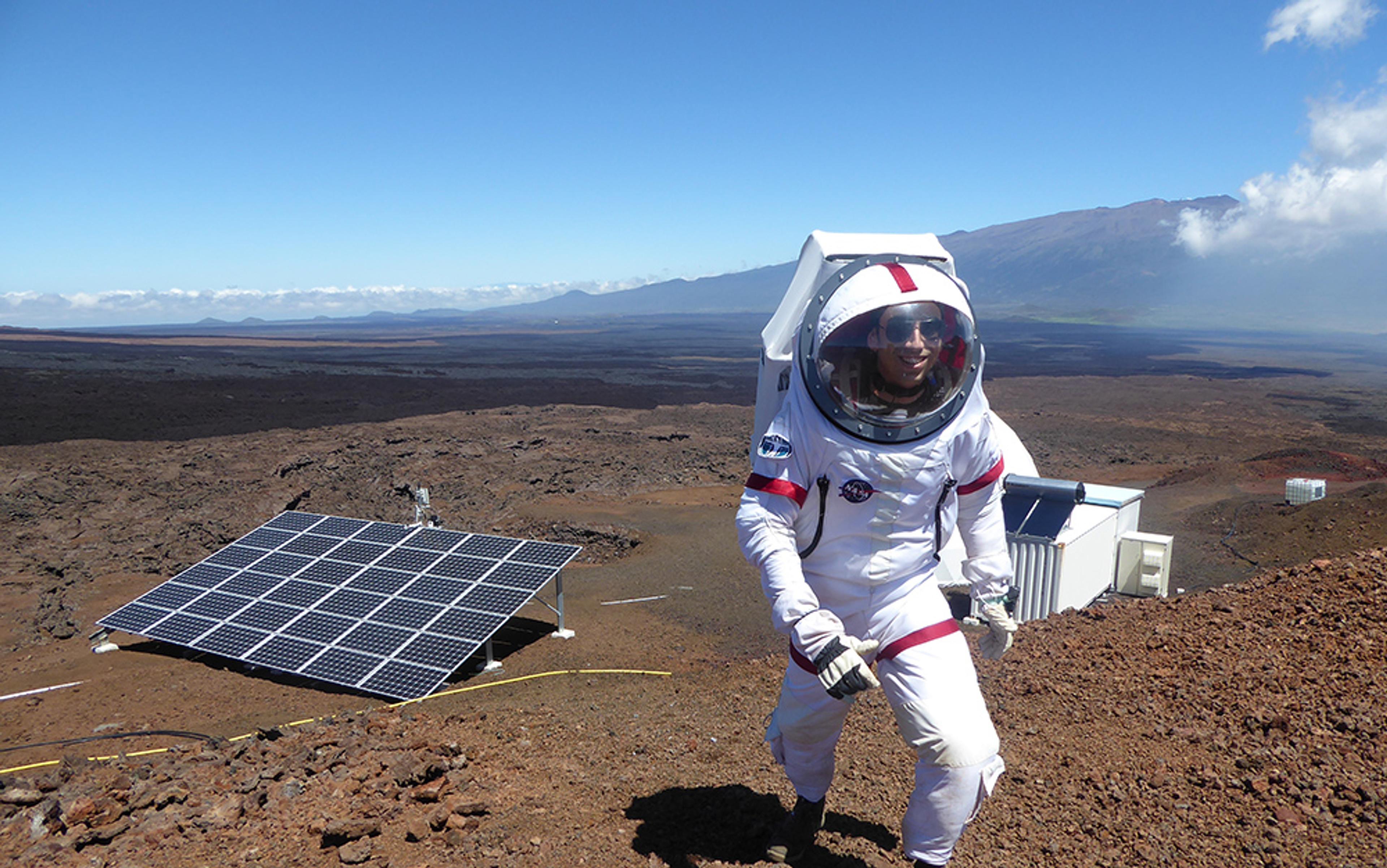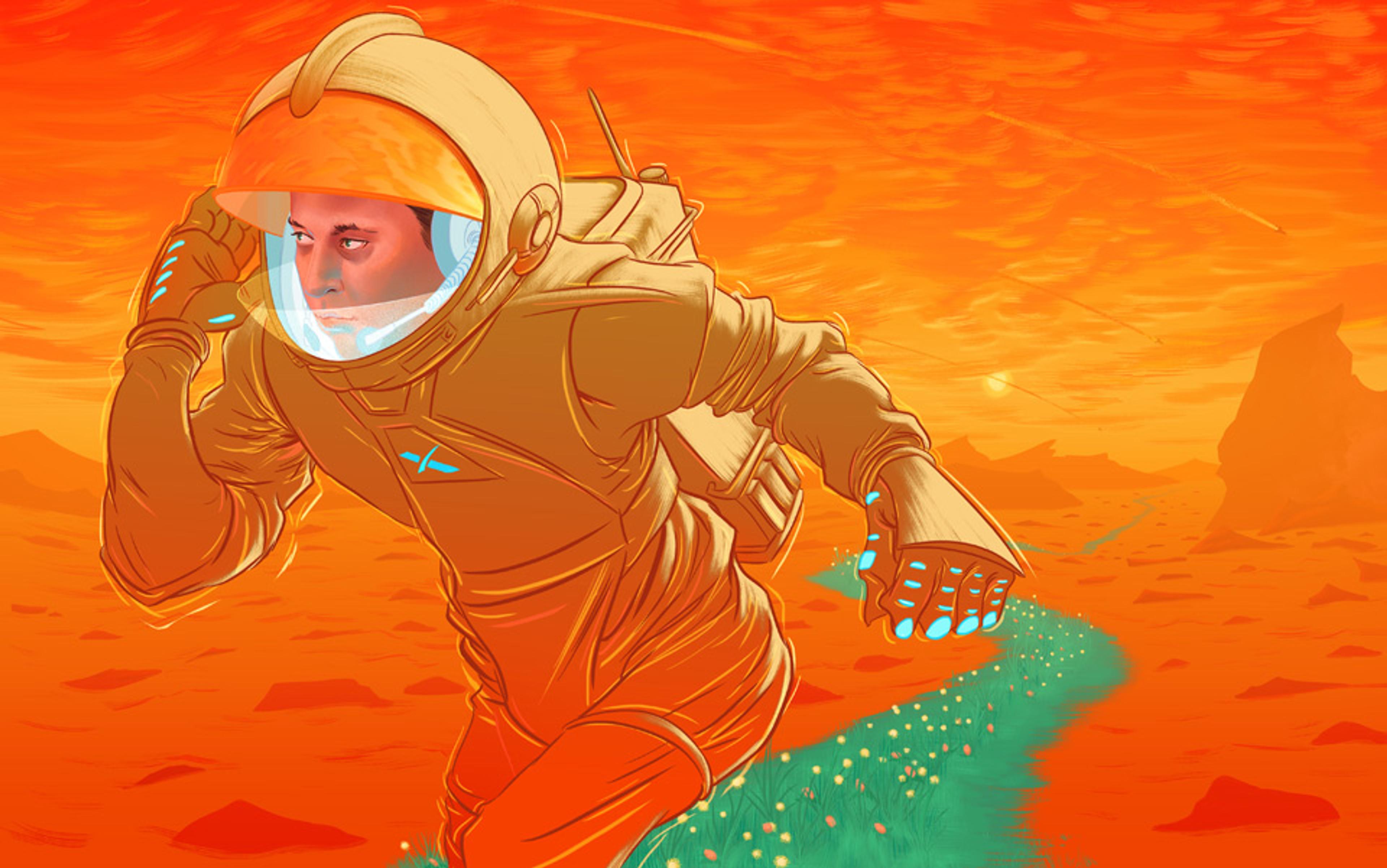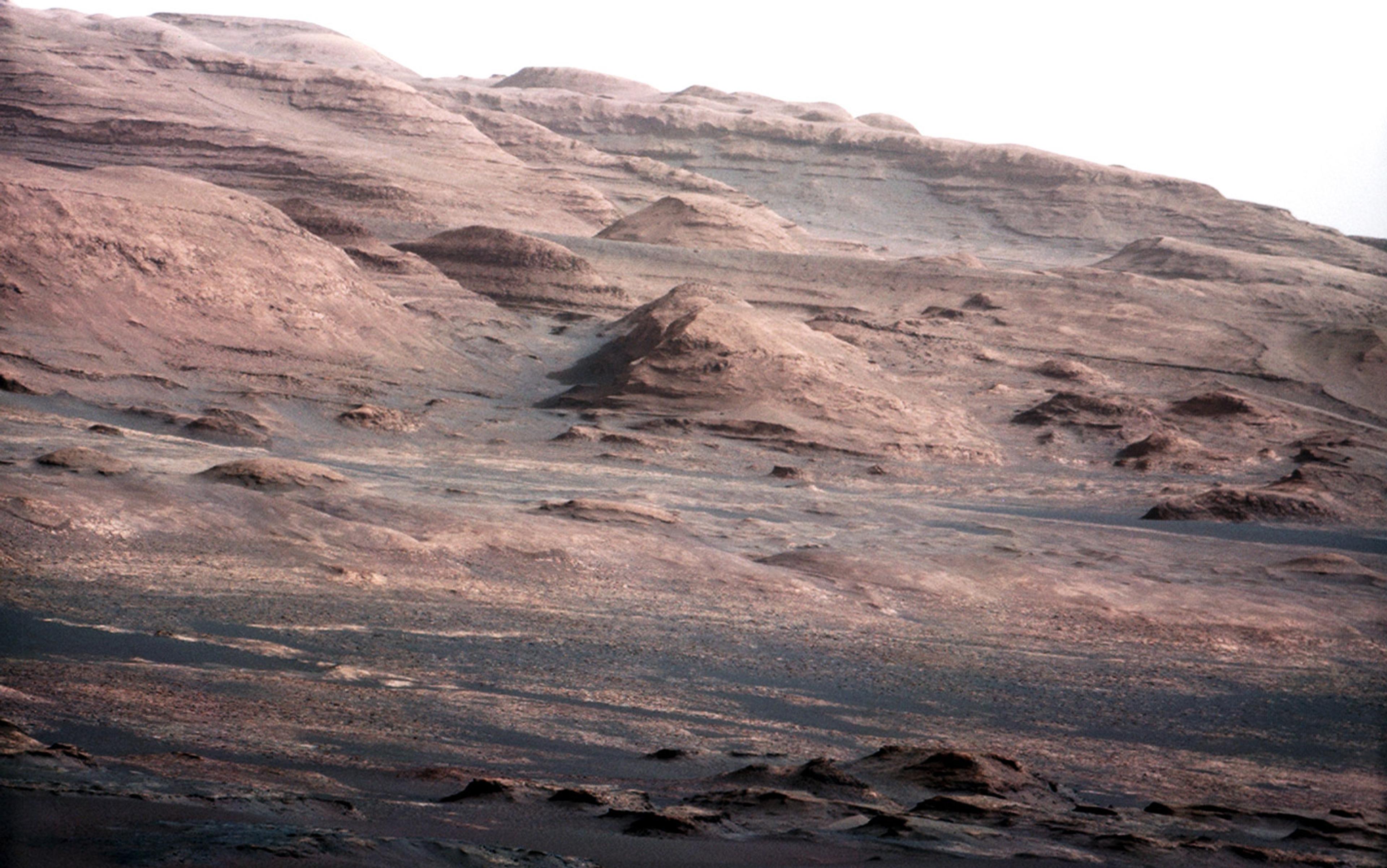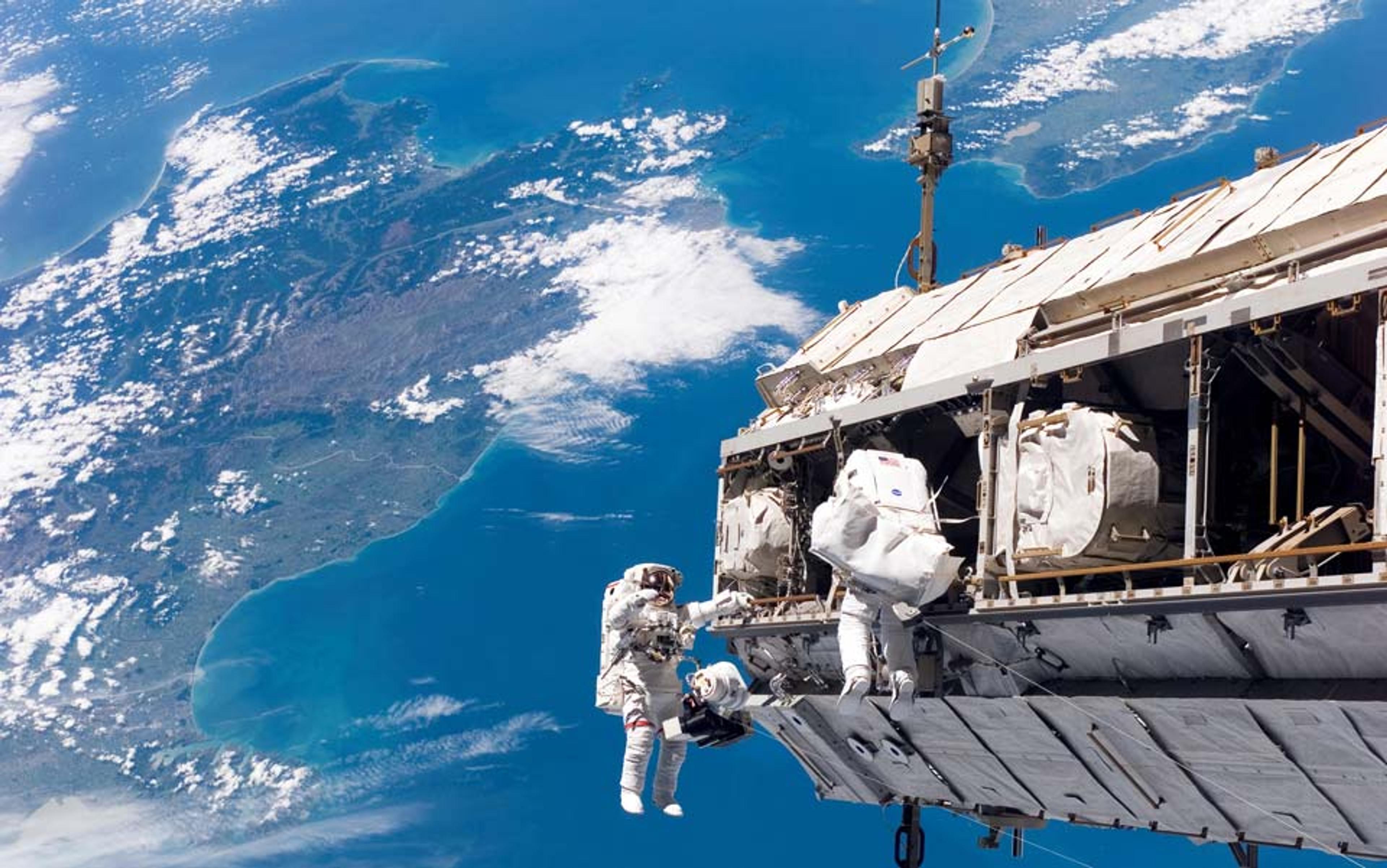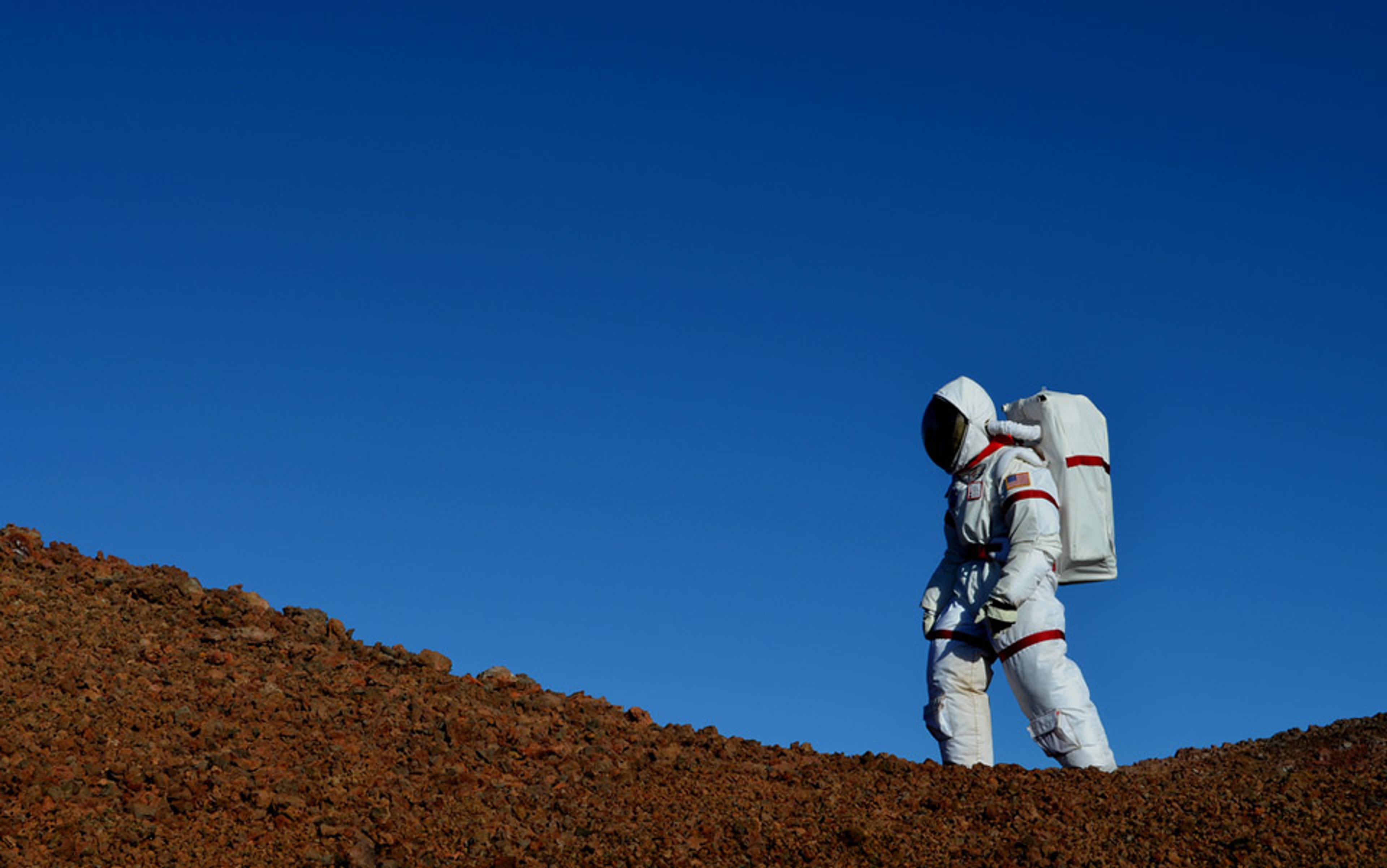I don’t quite remember what it’s like to wake up on Earth. Five months after ‘landing on Mars’, my day begins in a white dome in the middle of a red lava field, and I wonder: do we have enough power to turn on the heat? Will the weather let us suit up and check the greenhouses? Are my air fans going to work?
These thoughts circle in my brain as I pad downstairs for that first cup of something warm. The news that awaits me there will be in watts, percentage humidity and degrees Celsius, telling me what happened in and around our habitat overnight, and how much power we’re likely to have for the rest of today. I will hear water churning in the hydroponic systems, along with the hum of the lurid pink growing lights in the biology lab. I will see the same crewmates, kitchen and two-foot round porthole I’ve seen every morning for five months. That view of the jagged rocks beyond is a constant reminder that our world – this world we’re sharing for one year as a test run for life on Mars – is hostile and mysterious.
Let’s be clear: simulated Mars (or sMars) is technically your world. The six of us landed on the big island of Hawaii in late August 2015. A few days of training later – this is how you use the power systems, that is the right way to tap on the water tank, here is how to get into a spacesuit without dislocating anything – the door to the airlock shut, and we were ‘off planet’ for a year and a day, camped on the slopes of Mauna Kea. As simulated astronauts, we are a deliberately diverse crew: a space architect, an engineer, three scientists and a crew doctor (me). When we emerge on 28 August 2016, we’ll be veterans of the longest NASA-funded Mars simulation in history.
At first, our mission garnered only modest attention. Then The Martian was released, and all heck broke loose on sMars. The media came calling, only to be stymied by our mission’s inability to use a telephone. For this entire year, we are on a 20-minute communication delay, which applies in each direction, reflecting the maximum light-time travel between Mars and Earth – essentially, how long it takes a message from one planet to reach the other when the two are as far apart as they can be. For good and ill, we can’t take calls or have Skype interviews; we can’t do live media appearances; can’t be filmed, photographed or recorded in any way, except by ourselves.
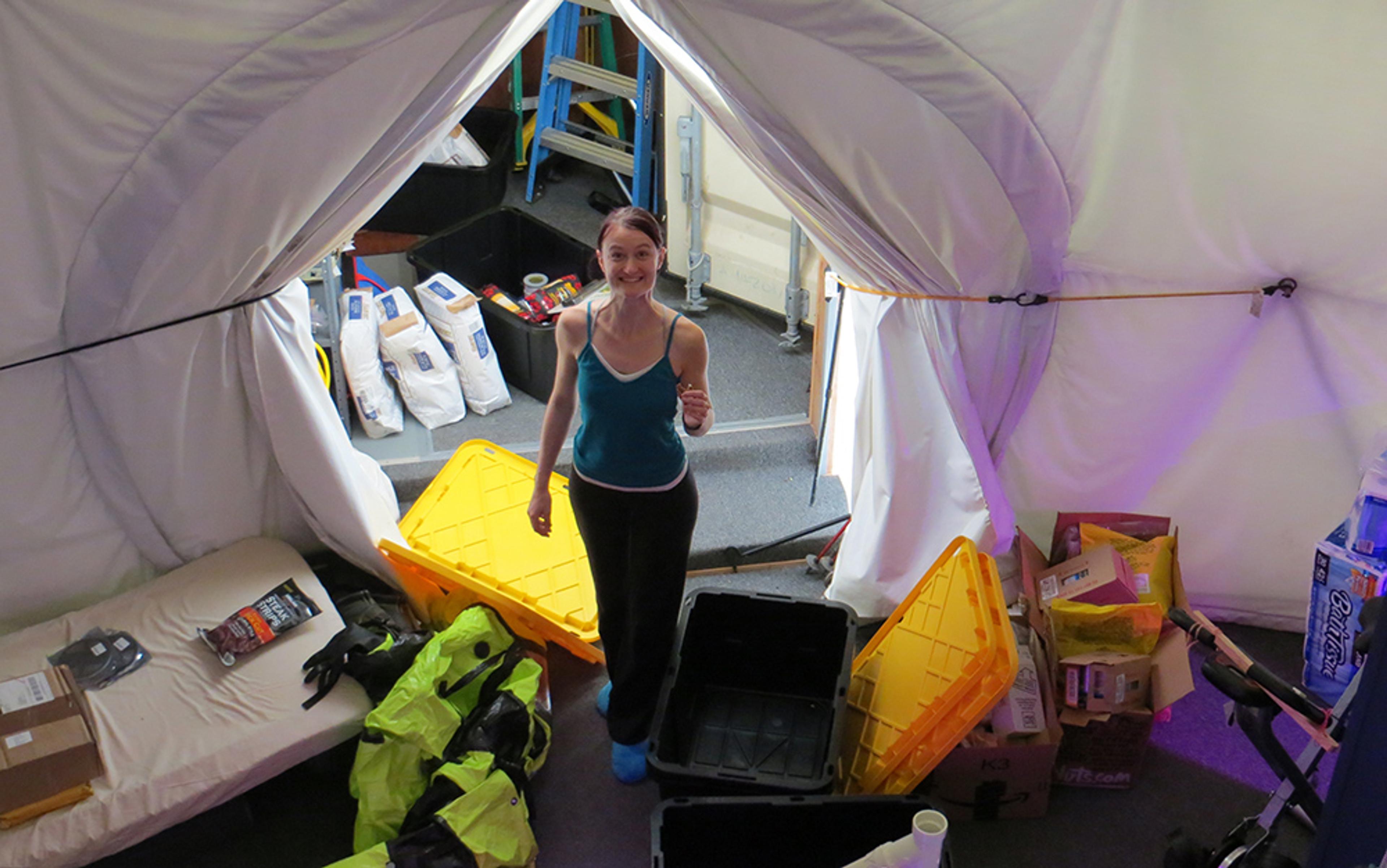
Chief Scientific Officer Christiane Heinicke enters the main area of the dome from the airlock during a HI-SEAS resupply. Photo by Andrzej Stewart
Not only is the light-time delay an effective filter, it is also a critical part of the psychological construct that keeps us, and everyone back on Earth, behaving as though the six of us really are on Mars. Simulating the time gap created by millions of miles of space allows researchers to study how communication works, or doesn’t, when every message between the crew and mission control takes 40 minutes for a response. Think about how a delay like that affects the classic space-movie scenario: ‘Houston, we have a problem, and.... we’ll hear back from you about it in three-quarters of an hour.’
Though it spares us certain headaches, the light-time delay makes life here more precarious than it would be otherwise. The 20-minute communication gaps might be technically artificial, but in many ways they are as real to us as the dome we live under. Take the way we’d deal with medical disasters. Unlike in deep space, on sMars, I can dial 911. Even so, it will be hours before we get a response. So, what happens in a medical disaster? It’s on me, the space doc, to fix it, if possible.
The same goes for engineering problems. We’ve had water leaks in the airlock; as they are wont to do anywhere in the known Universe, appliances have self-destructed; and our hydrogen fuel cells have never worked quite right. For such issues, the chief engineer and crew take care of it, if we can. For food and water, we get periodic supply drops. In between, we subsist on what we have, just as the eventual Mars crews will, and we do our best to live within our limits.
That needful sense of independence from Earth – and interdependence on each other – is the huge upside to the long, dark, 20-minute delay. Plus, without a phone or internet to distract us, we get lots of work done. Also, without those familiar lines of connection, it’s almost like we’re alone together on another planet – which, when you live in a dome at 8,000 feet above sea level on the barren side of a volcano, is sort of the idea.
We’ve learned to repair, repurpose and rebuild things we never would have otherwise. For months, a blue latex tourniquet has been holding parts of my electricity-producing bicycle’s motor in place. We’ve learned that a two-gallon plastic pretzel jar is perfect for growing certain species of bacteria, as well as for filtering water through volcanic rock. On sMars, where there is neither money nor anywhere to spend it, value is based almost solely on usefulness: of an object, a task, even a person.
Life on sMars, like on Mars itself, is elemental. Our chief concerns revolve around sun, air, water and rock – specifically, what we can and can’t do with those four basics in the right combinations. The Sun creates our energy. We, in turn, transform that energy into artificial light, in colours of the spectrum that most please our plants. The plants take up water, and set their roots in rocks that we’ve gathered from the surface. Their stems reach up towards the light, and our hopes grow with them: exhaled by the green leaves, born in the flowers that will bloom into fruit.
if our French astrobiologist placed a bowl of that green bacteria before me, I’d try it
All of that has to take place inside our dome – an analogue of what life on Mars might be one day. The analogue is necessarily imperfect. On real Mars, the air is extremely thin and composed mostly of carbon dioxide. Because it is not shielded by big radiation belts like Earth’s, Mars’s atmosphere is constantly being blown away by the Sun. According to MAVEN, a Mars-orbiting satellite built by NASA, the solar wind is stripping away 9.6 tons of atmosphere a day. To make matters worse, the surface of Mars is being irradiated in a way that Earth has probably never had to deal with – not since life began, anyway. Here on sMars, we fare far better: we have breathable air at a comfortable temperature and pressure, held by full Earth gravity. We have comfy, natural radiation shielding, and regular robotic supplies of food and water. Not frequent, mind you, but often enough to keep us going.
In between visits from the robots, we make the most of the resources we find. When conditions are right, we can pull water from the ground using small plastic tents. Future Mars crews will have to figure out some equivalent way to access their own local water source. We brought along seeds, soil, and a special kind of bacteria. Cyanobacteria, as the name suggests, are green. In the bottle, they look thin and luminescent, like jello before it congeals. These versatile little creatures can convert carbon dioxide into breathable air. They can purify water. They can feed off the sparse Martian menu, using nitrogen from the air and minerals from the ground, or they can consume urine and break down our waste. Purely by living, breathing, eating and excreting, these little bacteria turn soil that’s been dried and fried under the pink Martian sky into a useful growing medium, and in the process make everything from biofuel to proteins – proteins by the ton, potentially – for future Martian colonists.
Wait, you say: you’re eating green bacteria? The answer is not yet, but if our French astrobiologist placed a bowl of them before me, I’d try them. When every morsel of food in storage is some shade of just-add-water, anything fresh – even bacteria – becomes vastly more appealing, not just for taste but for health reasons. We need to eat living things to continue living ourselves. So we operate like a collective of scientist-farmers, each taken to growing or culturing something: herbs, sweet peas, grass (surprisingly tasty), tomatoes, bread, yoghurt. Without our crops and cultures, healthy food would be on the endangered list, and so would we.
Collaboration is one of the key motivations behind the sMars project: to find out what people need to live, work and survive together on other planets, and how to give it to them. The idea sounds simple in principle, but is difficult in practice. To work together effectively, people need more than just food, water and energy. Shared mission goals help, but they still aren’t enough to keep people happy for months on end. So what is enough? The belief – the hope – is that there’s a recipe for making it work: that the right people, given the right tools, can live together in a small space under stressful circumstances for years and continue to perform at near-peak levels, the way that astronauts do when in low-Earth orbit aboard the International Space Station. Our jobs as simulated astronauts is to test out potential ingredients for that recipe.
What this means is that life up here is eclectic, experimental, and occasionally unpredictable. There are scheduled tasks, unscheduled time for play and rest, experimental communication methods, virtual-reality trips to beaches and forests on Earth, and a lot of negotiation among the crew. Moving into the dome is a bit like suddenly having five spouses. You rapidly discover that what’s clean, polite, or acceptable to you won’t necessarily be clean, polite, or acceptable to someone else. Since we’re all here for the long haul – breaking up is not an option during a space mission – we’ve each had to adapt in five different directions at once as quickly as possible, while also doing our jobs.
I have all the time in the world. I only had to leave the planet to get it
Learning how to do that has been the most challenging part of the adventure. On the surface, it’s straightforward. I’m the space doctor. I keep everyone healthy while we run through the physical, psychological and emotional mazes before us. That sounds pretty futuristic, and it is, sort of. But without a hospital, pharmacy or medical laboratory, space medicine turns out to be pretty old-school. Healthcare on sMars resembles the time when doctors were trained scholars with some tools and a few supplies who made house calls.
Space medicine, as it will be practised on Mars and beyond, is a trip into the unknown. Not only can’t you take all the machinery, drugs and tests with you, but when you have six people in a habitat the size of a modest apartment, you have to quickly make some unorthodox choices. For example, where to treat people when every square inch is either reserved for science or functionally used as common workspace? I keep the bulk of my supplies in the biology lab, but there is no privacy there for an exam. So, like my father, a psychiatrist who maintained a home office, I treat people in my crew quarters. My room, at least, has a place to lie people flat, and a door that closes so we can chat freely about whatever ails them, be it mental or physical.
Turning my quarters into a doctor’s office solved one issue, but many more aren’t so easy. I am most troubled by my limited treatment options. Again, I fall back on the past to make a go of it in the present, and look for something I can dispense in lieu of pills, powders and poultices. In the places of those scarce or non-existent resources, I offer something I have in abundance: my medical insights about what they’re experiencing, why, and how to manage it until it heals itself. This mode of operation can sometimes leave me feeling inadequate. Then, I remember: since before the dawn of civilisation, healers in all societies have fallen back on these same techniques.
Maybe here, at civilisation’s edge, is as good a place as any to go back to the traditional regimen of sitting, listening, asking and explaining. Maybe I can’t write a prescription and make it all go away but, for once, I’m not expected to. There’s no line of patients waiting to see me. I have all the time in the world. I only had to leave the planet to get it. In that way, sMars is sort of a dream come true. In several other ways – the minimal medicines, tests, and treatments among them – it’s a daily nightmare.
In this white dome on this red planet we all come face to face with what we love, what we lack, what we need to live, and what we fear the most. I’m a skydiving, worlds-travelling, motorcycle-riding doctor. I’m not accustomed to needing much or fearing much. After college, I bummed across Australia with only a backpack. I camped on a beach for more than a week, living off beans and what I found in the bush, and was fine. Even as a kid, I was afraid of just one thing: Jupiter. I had a recurring dream that I was flying toward that gas giant, skimming over the fractured ice surfaces of Europa and Ganymede. Closing in on Io, with its spotted mask of volcanoes, I would think: ‘Too close! Too close!’ and wake up. Those were the only nightmares I ever had until medical school, when, napping on a cot in some dark corner, my fear of a giant planet morphed into a terror of missing hospital pages. I would wake with a start, convinced that I’d slept through a call to a bedside consultation, an emergency surgery, or my last chance to say goodbye to a patient.
On sMars, I have a new fear as a constant companion. My worry about this mission, and about any space venture, is that the emergency call will come and I’ll be right there, but totally unable to help. There will be no ventilators, no ICUs and no blood transfusions, unless we staff the mission only with type-O astronauts (not a bad idea). Thankfully, I haven’t had to find out yet. The only surgery I’ve done so far is wart-removal. As much as I enjoy suiting up and going in with a syringe of anaesthetic and a scalpel, I’ll be happy if my Martian edge-wielding ends at that big toe. That’s another strange thing about space: what would have been a boring day at the office back on Earth is almost too much excitement. On Earth, heart attacks and strokes are routine parts of a day’s work. Here, life is so precious and precarious to begin with that having to stitch up a crewmate after a fall on the rocks is a high-level manoeuvre.
Replicating the Martian experience means no direct sunlight or wind on our faces for an entire year
Nothing I’ve ever done – not even night shifts in ER – has drawn more attention to the frailty of the human form than donning a space suit. On sMars, you have to suit up every time you leave, just as humans will when we get to Mars. A space suit is an entire ecosystem that follows you around, feeding and watering and warming you. It marks you as a tenderfoot from a gentle world. You are wrapped and padded to the point where you can visit places where our form of life was never designed to go and return in one piece.
Five months into our expedition, we are missing parts of the terrestrial environment we used to take for granted. Replicating the Martian experience means no direct sunlight or wind on our faces for an entire year. No rainfall, either. Even those of us from Southern California are used to seeing rain once in a while. Water falling from the sky – the sky! – hasn’t happened on Mars in… hundreds of millions of years. In the future we’re trying to build, we will have to learn how not to fear the various deprivations. We’ll have to learn to embrace them instead, beginning with our own, very real, human limitations.
It is a given that the success of a future Mars colony will depend on developing the right technology, but a crucial lesson from sMars is that technology is the lowest common denominator. Mechanical solutions for getting a crew there and back alive will take shape as time and money allow. What cannot be engineered is people. Physically and mentally, emotionally and spiritually, we are the black boxes in this white dome bound for the red planet.
Physiology is tough to outwit, though we’re making some progress. With artificial gravity and good radiation shielding, we might dodge some of the worst of what happens to the body in space. What will then remain, standing between us and our goal of becoming an interplanetary species? The same forces that drive our most basic behaviour on this planet: individual psychology and group dynamics. How we get along with each other (and with ourselves) is what allows our exploratory missions to succeed, or what dooms them to failure. Unlike temperature, humidity and power supply, mental states cannot be fully accounted for beforehand. Or can they? What if there is some secret to living in harmony that we can discover by practising beforehand on sMars?
This is what the six of us came here for: to get along and, in the process, help press humanity outward into the Universe. To hasten the day when people put boots on Mars, and probe its surface for signs of past or present life. In the meanwhile on this barren hillside, we are also finding something of our essential natures. True, whenever we venture into the wilderness, we confront the limits of self-sufficiency and a heightened dependence on those around us. Also true: most of us never experience anything more intense than a camping trip, where you can only get so lost before you run into civilisation again, or it comes looking for you. On Mars and beyond, the experience will be taken to a new level. Ponder this: how would it change your worldview if every person you laid eyes on for years was utterly necessary for your survival? That’s life on sMars, and that will be life on real Mars: distant and inhospitable, populated entirely by people you cannot live without, and who cannot live without you.
I imagined many things about this trip. I practised for a long time to go to Mars. It turns out that Mars is just a place on whose surface rests a dome. The dome itself is just a fancy box. With the hatch closed, the world contracts not into 1,200 square feet of storage, scientific equipment and medical supplies, but into six human bodies. We form a single unit, unmappable but not unknowable, with vast minds and complex pasts; with disparate beliefs, preferences and desires. The contents of the whole world is them – is us.
When I wake up tomorrow, the entire world will be within earshot. I’ve never been able to say that before. No matter where I go on Earth, I’ll never be able to say it again.
